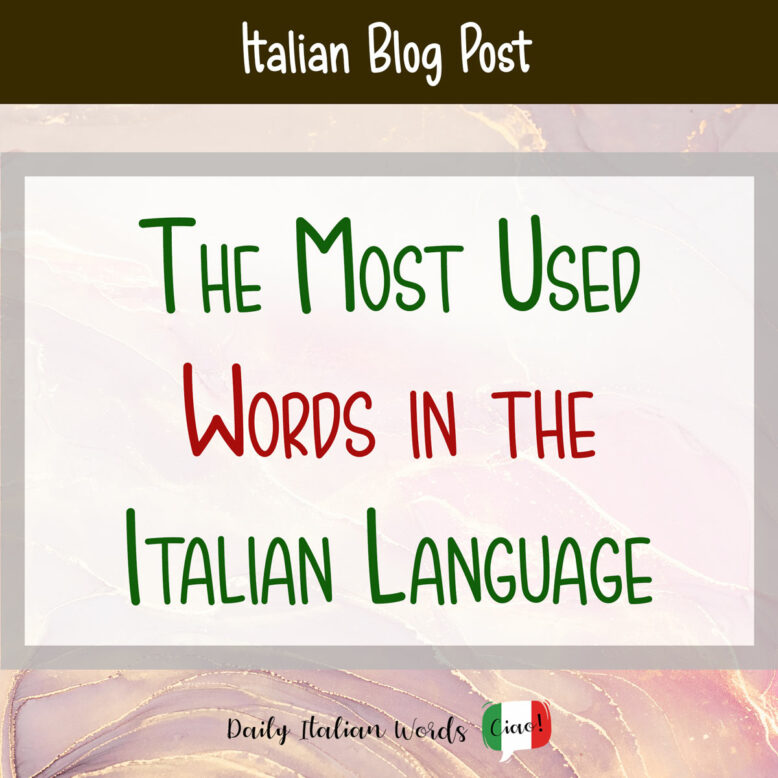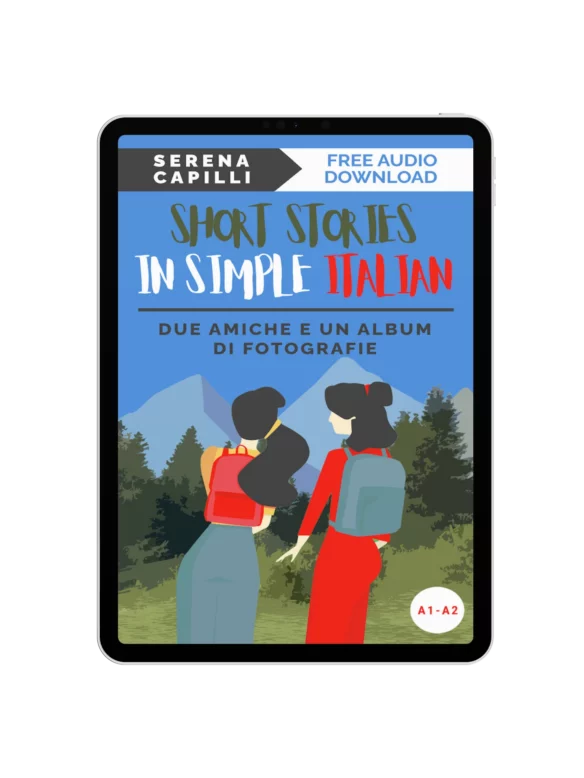We Italians take great pride in our rich and melodious our language. And yet, despite having thousands of beautiful words at our disposal, we somehow end up using the same ones. But hey, there’s a reason we do it: these words are incredibly versatile and often convey different meanings depending on the situation. That’s why knowing them will absolutely help you with basic conversations in Italian.
So, curious to know which are some of the most used words in Italian? Here are 15 of them to start!

1. Bellissimo/a
Whether it’s a breathtaking view, a delicious meal, or just a particularly good day, bellissimo is our go-to adjective. We use it to express genuine appreciation, not just for aesthetics but for anything that brings us joy or admiration.
That view at the top of the hill? Bellissima! The movie you can’t stop thinking about? Bellissimo! Your friend’s half-burned cake? Still bellissima! (it’s the effort that counts, right?). Sure, there are many synonyms for bellissimo/a, but those melodic double “l” and “s” sounds are hard to resist!
Questa casa è davvero bellissima!
This house is so beautiful!
2. Casino
You may not be familiar with this word, but casino definitely deserves a spot on the list because, well, we say it all the time.
It’s a casual, everyday word used to describe anything loud, chaotic, or completely out of control:
C’è un casino in piazza, è successo qualcosa?
There’s a mess in the square, did something happen?
Serena ha fatto un casino alla festa ieri.
Serena made a scene at the party yesterday.
This meaning actually comes from its origins: casino once referred to, among other things, a brothel, which was probably not the most orderly place. Hence, the association with noise and confusion.
In informal Italian, casino also means “a ton” of something:
Quest’anno ho preso un casino di multe!
This year, I got a ton of fines!
Mi piace un casino questo posto!
I love this place so much!
Just be careful with your pronunciation: if you stress the wrong syllable, people might think you’re talking about a casinò (a gambling house) instead of a casino (a total mess). But then, depending on how your trip to the casinò goes, you might end up with un casino (a lot) of problems!
3. Caro/a
In its most basic form, caro/a is an adjective that means expensive:
Questi sono un po’ troppo cari, avete qualcosa di più economico?
These are a little too expensive, do you have anything cheaper?
But caro/a is not just about money. It’s also a way to express affection, meaning “dear,” “beloved,” or “precious.” It can refer to people, memories, or even that little gondola that brings back sweet memories from your Italian trip.
Sara è una mia cara amica.
Sara is a dear friend of mine.
And then we have the sweetest usage of all: a term of endearment, similar to “darling.” But it’s not just for lovers, we use it in everyday interactions, sometimes even with strangers or acquaintances, so don’t be surprised if even the local baker or barista greets you with:
Cosa ti do, cara?
What can I get you, darling?
4. Cavolo
How did a word like cavolo, which literally means “cabbage”, make it into Italian everyday speech? Well, it sounds quite similar to a much more colourful Italian word that many of us love to use for emphasis (cazzo). But since dropping cazzo in every sentence might not be the most polite choice, cavolo is the perfect, more socially acceptable alternative. And we use it in all sorts of situations!
We say cavolo when we want to strengthen a negative phrase, similar to “damn” in English:
Non capisci proprio un cavolo!
You don’t understand a damn thing!
Che cavolo state dicendo?
What the heck are you saying?
We use it also to express surprise, especially when something catches us off guard:
Oh cavolo, quand’era la riunione?
Oh shoot, when was the meeting?
Just like you say “wow” in English, we use a vegetable—cavolo—to express our admiration or amazement at something:
Cavolo, parli benissimo il portoghese!
Wow, you speak Portuguese so well!
Another reason cavolo is one of the most commonly used words in Italian is because it has sprouted tons of fun expressions that are regularly used in casual conversations, for example: un cavolo (nothing), cavolata (nonsense), cavoli amari (serious trouble), cavoli miei (my problems), incavolato (pissed off), sa il cavolo (who knows), grazie al cavolo (obviously), and many more.
5. Cosa
If you don’t know the right word, if you want to be vague, or if you just can’t be bothered to be specific, cosa is the perfect word to use. And it covers everything, from objects to abstract concepts.
Per quella cosa che ti ho detto, ne parliamo domani, va bene?
About that thing I told you, we’ll talk about it tomorrow, okay?
Dopo passa da me che ti devo chiedere una cosa.
Stop by later, I need to ask you something.
In some cases, cosa can refer to a topic, situation, or problem:
Dobbiamo chiarire questa cosa con il cliente il prima possibile
We need to clarify this matter with the client as soon as possible.
When asking questions, cosa means “what”:
Cosa preferisci per cena?
What do you prefer for dinner?
While cosa on its own is super common, we also use che and che cosa interchangeably, so don’t stress too much about which one to pick, they all work!
In the plural form, cose can mean “things” in general or “stuff” in a more personal sense:
Lascia sempre le sue cose in giro per casa!
He always leaves his stuff all over the house!
Or, in a completely different context, it can be used as a slang for a woman’s period:
Oggi non sta benissimo, ha le sue cose.
She’s not feeling great today, it’s that time of the month.
And, of course, we have quite a few fixed expressions with cosa, including fra le altre cose (among other things), per prima cosa (first of all), and contare qualche cosa (to count, to matter).
6. Fare
After essere (to be) and avere (to have), which I haven’t included here because they are the absolute basics, fare (to do, to make) is hands down the most used verb in Italian. We combine it with all sorts of other words in everyday speech. So, to sound Italian, master fare and you’re already halfway there.
Here are some everyday examples:
- Fare attenzione (to pay attention)
- Fare coraggio (to encourage)
- Fare gli anni (to have a birthday)
- Fare i biglietti (to buy tickets)
- Fare soldi (to make money)
- Fare sport (to practice sport)
- Fare un discorso (to make a speech)
- Fare un favore (to do a favour)
- Fare un viaggio (to travel)
- Fare una domanda (to ask)
- Fare una foto (to take a picture)
And the list could go on forever! So, when in doubt, just use fare plus a noun and chances are, you’ll be well understood by any Italian.
Fare also appears in a series of fixed expressions like saperci fare (to be good at something), fare caso a qualcosa (to pay attention to something), and avere a che fare (to deal with something).
7. Giorno
Giorno is another one of those words you can’t escape in Italian. It literally means “day,” but we use it in many different ways, from marking time to casual greetings.
First of all, we use giorno when talking about a calendar day:
Che giorno è oggi?
What day is it today?
Giorno can also refer to a 24-hour period:
Ci vuole ancora un giorno per arrivare a destinazione.
It will take another day to reach the destination.
We use it also with the meaning of “daytime,” as opposed to night:
Preferisco studiare di giorno, la sera voglio rilassarmi.
I prefer to study during the day, in the evening I just want to relax.
Giorno often pops up when talking about special occasions:
Cosa indosserai il giorno del matrimonio di tuo fratello?
What will you wear on your brother’s wedding day?
Just like in English, where you can drop “good” and say “Morning!”, we often shorten buongiorno to just giorno for a more casual greeting:
Giorno a tutti!
Morning everyone!
And of course, we use many set phrases with giorno, including al giorno d’oggi (nowadays), un giorno o l’altro (one of these days), and piatto del giorno (dish of the day).
8. Mica
Mica is a tiny adverb you’ll hear all the time in Italian, because it adds emphasis, irony, or a casual tone to a phrase.
When used in a negative sentence, mica makes the negation stronger, often conveying a certain surprise or disbelief:
Non vorrai mica tirarti indietro proprio adesso?
You’re not going to back out now, are you?
Another classic use of mica is when expressing playful reassurance. A classic scenario is when we offer food to someone, and they hesitate; we love to joke about this by saying:
Non è mica avvelenato!
It’s not like it’s poisoned!
Similarly, we use it to playfully dismiss an exaggeration:
Dai, non è mica la fine del mondo!
Come on, it’s not the end of the world!
In questions, mica softens the request and gives it a casual tone, like saying “by any chance” or “perhaps” in English:
Hai mica due euro da prestarmi per il caffè?
Do you by any chance have two euros to lend me for coffee?
And when something doesn’t match your expectations, mica helps express doubt (or adds a touch of irony when we already know the answer):
Ma non dovevi mica restare a casa stasera?
Weren’t you supposed to stay home tonight?
Lastly, we have a few common expressions with mica such as mica tanto (not really), mica male (not bad), and mica pizza e fichi (not just something simple or trivial).
9. Paese
Paese is a deceptively simple word with some important nuances depending on the context and its capitalisation.
When you see Paese written with a capital P, it refers to a nation or country. This is the formal, official use of the word:
Il nostro Paese sta attraversando una forte crisi economica
Our country is going through a serious economic crisis.
But when written with a lowercase p, paese takes on a more local meaning, referring to a village or small town:
Abito in un paese a mezz’ora da Milano.
I live in a small town half an hour from Milan.
Beyond just the physical place, paese can also mean the people who live there (essentially, the locals or the entire community):
Ieri sera alla presentazione c’era tutto il paese.
The whole village was at the presentation last night.
Naturally, paese also appears in everyday Italian expressions, adding even more layers to its meaning. These include: mandare a quel paese (to tell someone to go to hell), tutto il mondo è paese (the world is the same wherever you go), and il paese dei balocchi (a situation that’s too good to be true — this is inspired by Pinocchio, where kids are lured into a magical land of fun, only for things to go terribly wrong).
10. Parte
In its most basic meaning, parte refers to a portion of something larger:
Ho ricevuto solo una parte del rimborso.
I only received part of the refund.
Tuo fratello ha la sua parte di colpe.
Your brother has his share of blame.
When talking about locations or asking for directions, parte helps specify a side or area.
Da che parte devo andare per il Colosseo?
Which way should I go to reach the Colosseum?
Dalle mie parti si produce un ottimo vino rosso.
Where I live, they produce some really good red wine.
Paired with prepositions, parte forms expressions that we use all the time, such as in parte (partially), a parte (other than, apart from), da parte (aside), and da qualche parte (somewhere).
There are also expressions with parte that can come in handy when conversing in Italian, for example: far parte di (to be part of), fare la propria parte (to do your part), fare la parte di (to play the part of), farsi da parte (to move out of the way), and mettere da parte (to put aside). By the way, notice how many of these include the verb fare?
11. Posto
Posto is an incredibly versatile Italian word and can even function as a verb.
Its primary meaning refers to a space, whether a physical location or something more metaphorical:
C’è posto per tutti, non spingete.
There’s room for everyone, don’t push.
Avete un posto speciale nel mio cuore!
You have a special place in my heart!
A classic Italian phrase you’ll hear all the time is tutto a posto, which is the typical way of saying “everything is fine” or “everything’s sorted out” in Italian:
Ciao, come va? Tutto a posto?
Hey, how’s it going? Everything good?
Another very common use of posto is the phrase a posto così. This is often used when concluding a sale to confirm whether someone has everything they need:
Ecco l’insalata e le mele. A posto così?
Here’s the salad and the apples. Is that everything?
When things are not going well, we like to use the expression siamo a posto, as a sarcastic remark. It’s like saying “Well, that’s just great!”:
Ci hanno pure cancellato il volo, siamo a posto!
They even canceled our flight, that’s just great!
There are also several fixed expressions with posto, which come up in everyday conversations. Some examples include: mettere a posto (tidy up), avere la testa a posto (to be of sound mind), stare al proprio posto (to know one’s place), and perdere il posto (to lose one’s job).
Finally, posto is also the past participle of the verb porre, which means “to put” or “to pose,” or “to set:”
Hanno posto delle condizioni assurde!
They set some ridiculous conditions!
12. Ragazzo / Ragazza
Ragazzo and ragazza literally mean “young man” and “young woman” and typically refer to people in their teenage or early adult years. However, we love using these words even when the person in question is no longer a teenager, though it all comes down to tone and the nature of the relationship. For example, you might hear someone refer to a grown man or woman as a ragazzo or ragazza in a tender, friendly, or even playful way.
It s also very common to use ragazzi and ragazze when talking about sons and daughters, no matter how old they are. It’s like saying “my kids” in English, even if they’re adults with their own lives:
I miei ragazzi vivono all’estero, uno lavora e l’altro deve finire l’università.
My kids live abroad, one works and the other has to finish university.
Another frequent use of ragazzo and ragazza is to refer to a romantic partner:
Il nuovo ragazzo di Elisa è davvero simpatico.
Elisa’s new boyfriend is really nice.
Italian also features some fun expressions that incorporate ragazzo and ragazza. Some examples include: cose da ragazzi (something silly or carefree), un gioco da ragazzi (a piece of cake), ragazzo padre (single father) and ragazza madre (single mother).
13. Signora / Signore
These are the grown-up versions of ragazza and ragazzo. While the latter is used for young people, signora (for women) and signore (for men) are used when referring to adults, and carry a certain respectful, formal tone.
We often use them when addressing someone by their last name:
Buongiorno Signora Rossi, come sta?
Good morning, Mrs. Rossi. How are you?
Signore and signora can also describe someone who’s elegant, classy, or well-mannered:
Gianni è un vero signore.
Gianni is a real gentleman.
It’s not unusual to hear signore/signora used playfully to describe something that’s excellent or impressive, implying that it’s top quality:
Questa sì che è una signora macchina!
Now, this is a really fancy car!
Finally, there’s the sacred side of signore: in Italian, it also refers to God, and when used in this context, it’s always capitalised:
Prego il Signore tutti i giorni.
I pray to the Lord every day.
14. Tempo
Tempo is another word you’ll use in various contexts, from talking about the passing of time, checking on the weather, or discussing age.
In its most straightforward meaning, tempo refers to the duration or passing of time:
Prenditi tutto il tempo necessario, la famiglia viene prima di tutto.
Take all the time you need, family comes first.
Quanto tempo manca per arrivare a Roma?
How much time is left to get to Rome?
We don’t use tempo to say “time” in the sense of specific moments (like, the time is 5 o’clock), but rather to talk about how much time or how long something lasts.
Another typical use of tempo is when talking about the weather:
Com’è il tempo oggi?
What’s the weather like today?
Tempo also comes in handy to ask about someone’s age, especially when talking about kids (or even pets):
Ma che bel bambino, quanto tempo ha?
What a lovely baby, how old is he?
Finally, in the context of sports or shows, tempo refers to the first or second half:
Ho preferito il secondo tempo del film.
I preferred the second half of the movie.
15. Tipo
Tipo is another fun and super practical word in Italian that works in so many situations.
We use is a lot when referring to a person we don’t know or simply don’t want to specify:
Chi è quel tipo che sta parlando con Marta?
Who’s that guy talking to Marta?
We frequently say tipo when describing someone or something that embodies a specific trait, quality or characteristic, similar to saying “ the type of” in English:
Claudio è il tipo di insegnante che vorrei diventare.
Claudio is the type of teacher I’d like to become.
In casual conversations, tipo helps to introduce an example, particularly when we’re trying to explain something:
Non mi piace il formaggio. Tipo, il gorgonzola proprio non lo sopporto!
I don’t like cheese. Like, I really can’t stand gorgonzola!
When asking questions, tipo serves as the Italian equivalent of “what sort” or “which kind” in English:
Che tipo di viaggi ti piace fare?
What kind of trips do you like to take?
Tipo is also used to give an approximation when we’re not quite sure of a precise number or time frame:
Saranno tipo tre anni che non si parlano.
It’s been like three years since they’ve spoken to each other.
Finally, in informal contexts, tipo can even mean a boyfriend or girlfriend (as someone’s significant other):
La nuova tipa di Simone è pazzesca, suona persino la batteria!
Simone’s new girlfriend is awesome, she even plays the drums!

Valentina Nicastro is a travel writer in love with her home country, Italy. Having travelled widely around the globe, she realised there was more to explore closer to home and decided to put the passport aside for a while. When she is not immersed in documenting Italy, you’ll find her donning her communication consultant hat, weaving words as a content writer and bridging linguistic divides as a translator.


